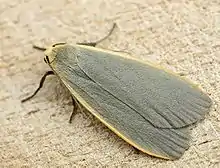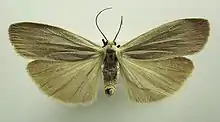Collita griseola
Collita griseola, the dingy footman, is a moth of the family Erebidae. The species was first described by Jacob Hübner in 1803. It is found in Europe and North and South-East Asia.
.jpg.webp)
| Collita griseola | |
|---|---|
 | |
 | |
| Scientific classification | |
| Kingdom: | Animalia |
| Phylum: | Arthropoda |
| Class: | Insecta |
| Order: | Lepidoptera |
| Superfamily: | Noctuoidea |
| Family: | Erebidae |
| Subfamily: | Arctiinae |
| Genus: | Collita |
| Species: | C. griseola |
| Binomial name | |
| Collita griseola (Hübner, 1803) | |
| Synonyms | |
| |
The wingspan is 32–40 mm. The moth flies from May to August depending on the location.
The larvae feed on lichen.
This species has shown a spectacular increase in abundance in Britain during the period 1968 to 2007, like a number of moth species with larva that feed on lichens and algae.[1] In Britain it was originally limited to southern fens and marshy areas, but has since spread northwards and now occupy a variety of habitats, including gardens.[1]
Subspecies
- Collita griseola griseola
- Collita griseola sachalinensis (Matsumura, 1930) (Russian Far East)
- Collita griseola submontana (Inoue, 1982) (Japan)
References
- Fox, R. (2013). "The State of Britain's Larger Moths 2013" (PDF). Butterfly Conservation. Archived from the original (PDF) on 17 May 2017. Retrieved 20 November 2016.
| Wikimedia Commons has media related to Eilema griseola. |
| Wikispecies has information related to Eilema griseola. |
External links
- Kimber, Ian. "72.044 BF2044 Dingy Footman Eilema griseola (Hübner, [1803])". UKMoths. Retrieved 11 July 2019.
- Eilema griseola at Lepiforum e.V.
This article is issued from Wikipedia. The text is licensed under Creative Commons - Attribution - Sharealike. Additional terms may apply for the media files.